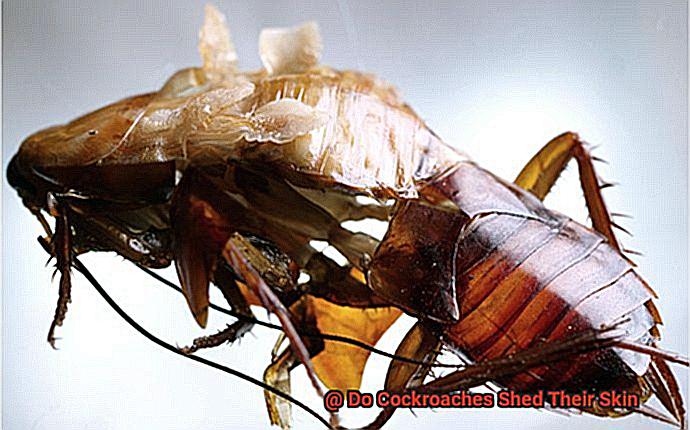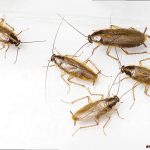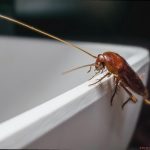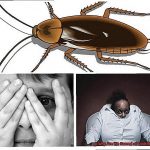Cockroaches – the mere mention of these creepy crawly critters is enough to send shivers down most people’s spines.
But did you know that these resilient insects have a secret weapon for staying in top condition? That’s right, they shed their skin regularly, just like many other insects do.
But why is this process so important for cockroaches, and what exactly happens when they molt? In this blog post, we’ll delve into the fascinating world of cockroach molting, exploring the intricate layers of their exoskeleton and how shedding helps them grow and develop.
We’ll also take a closer look at the implications of molting for cockroach health and survival, including how it affects their ability to move, hunt, and reproduce. And if you’re curious about the anatomy of a cockroach’s exoskeleton or want to know more about this strange but wonderful insect species, stick with us as we uncover all there is to know about cockroach shedding.
So, let’s find out.
What is Molting?
Contents
Molting is the process of shedding the outer layer of a cockroach’s body, known as the exoskeleton. This allows them to accommodate their growing bodies and develop a new exoskeleton that can fit their larger size.
It’s like trading in your old shoes for a new pair that fits better – except for cockroaches, it happens several times throughout their life. Molting is crucial for cockroaches to grow and reach their adult size and form.
During this process, their wings become fully developed, and any injuries or deformities they might have had previously can heal. However, molting also leaves them more vulnerable to predators and other threats as they are soft and unprotected after shedding their exoskeleton.
Therefore, they tend to hide in safe places until their new exoskeleton hardens. The frequency of molting varies depending on factors such as age, species, and environmental conditions.
Younger cockroaches tend to molt more frequently than older ones. If you see many exoskeletons around your home or business, it’s likely that there are many cockroaches living in the area.
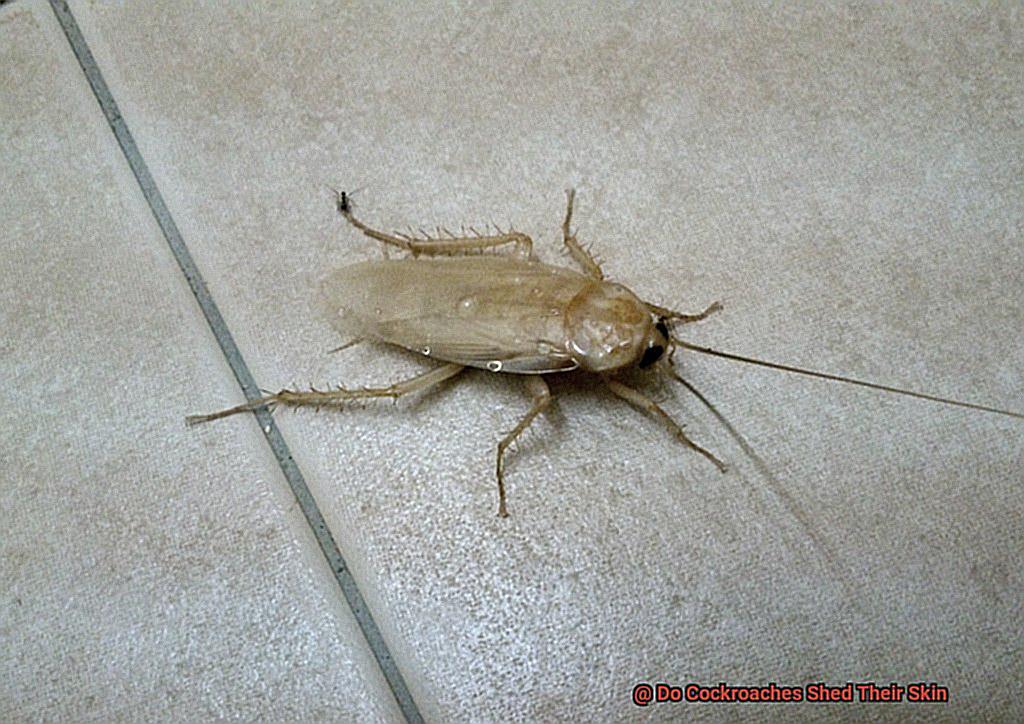
So, molting is a natural process that helps cockroaches adapt and grow throughout their life cycle. It’s essential for them to reach their adult size and form while healing any injuries or deformities they might have had previously.
How Often Do Cockroaches Molt?
Cockroaches are not only resilient and skilled survivors, but they also have a unique talent – the ability to molt.
It’s like they’re trading in their old skin for a new and improved exoskeleton, just like we would trade in our old clothes for a new outfit. But how often do these creepy crawlies undergo this process?
As it turns out, the frequency of molting in cockroaches depends on their species and age. Typically, younger cockroaches molt more often than older ones.
A baby cockroach may molt every few days, while an adult may only molt once every few months. On average, a cockroach will molt six to ten times before reaching adulthood, although some species may molt up to 13 times.
The time between molts is also influenced by environmental factors such as temperature and humidity. Warm and humid conditions can speed up the molting process.
However, it’s essential to remember that molting can be stressful for cockroaches, and they may become more vulnerable to predators during this time. Therefore, providing adequate food and water is crucial for a healthy molt.
After all, we don’t want these bugs stressed out and vulnerable in our homes. So keep them well-fed and hydrated.
The frequency of molting varies depending on the species and age of the insect and is affected by environmental factors such as temperature and humidity.
The Process of Molting
Cockroaches are the ultimate survivors, famous for their ability to adapt and thrive in almost any environment.
But did you know that one of their most extraordinary talents is molting? It’s a fascinating process that enables these pests to shed their old skins and grow into new ones.
Imagine trading in your old clothes for a new outfit, but instead of going shopping, you shed your skin – that’s what molting is like for cockroaches. They have an exoskeleton, a hard outer covering that provides support and protection.
However, this shell cannot grow with them, so they must shed it to make way for a new one. Molting starts with hormonal changes in the cockroach’s body that signal it’s time to shed its old exoskeleton.
The roach secretes a fluid that softens the old shell, making it easier to break apart. Then, the roach wriggles out of its old skin, leaving behind a white, papery replica of itself called an exuviae or cast skin.
After molting, the new exoskeleton is soft and vulnerable. So the cockroach hides until it hardens and darkens to provide better protection against predators and environmental hazards.
The frequency of molting depends on various factors such as species, sex, age, nutrition, and environmental conditions. Younger cockroaches molt more frequently than older ones as they are growing faster.
Females tend to molt more than males because they produce eggs that require nutrients from their exoskeleton. Molting is a vital process for cockroaches as it allows them to grow and adapt to changing environments.
Signs of Infestation
Cockroaches are notorious for their nocturnal habits, making it challenging to detect their presence until it’s too late.
Fortunately, there are five tell-tale signs of an infestation that you should be aware of.
- Firstly, keep an eye out for cockroach droppings in areas where they frequent, such as kitchens, bathrooms, and basements. These tiny fecal droppings look like black pepper or coffee grounds and can be found in cupboards, drawers, and behind appliances.
- Secondly, cockroaches emit a musty and unpleasant odor caused by pheromones they use to communicate with each other. The smell becomes more potent as the infestation grows and can be quite pungent.
- Thirdly, watch out for egg casings that look like small brown capsules. Cockroaches lay these in dark and moist areas such as behind refrigerators, under sinks, and in basements. If you see any of these egg casings around your home, it’s time to take action.
- Fourthly, cockroaches shed their skin as they grow, leaving behind empty exoskeletons. These skins can be found in cupboards, drawers, and behind appliances. If you spot these skins lying around your home, it’s a clear indication of an infestation.
- Lastly, if you spot live cockroaches scurrying around your home, then you have a severe problem.
These pests are fast and agile and can be challenging to catch. If you see one, there’s a good chance that there are many more hiding somewhere nearby.
A professional pest control company can help you eliminate the infestation and prevent future infestations from occurring.
H_HxwLHX8mc” >
Prevention Tips
Not only are these pesky insects unsightly, but they also pose potential health risks. Luckily, there are several prevention tips you can follow to keep your home cockroach-free. Here are five subtopics that will help you understand how to prevent cockroach infestations in your home.
Maintaining proper sanitation practices
Cockroaches thrive in dirty environments, so it’s essential to maintain proper sanitation practices to prevent infestations. Vacuuming regularly, mopping the floors, and wiping down surfaces can help eliminate food debris and crumbs that attract cockroaches. Additionally, store food in airtight containers and dispose of garbage regularly.
Sealing cracks and gaps
Cockroaches can enter through even the tiniest of gaps, so it’s crucial to seal any openings in walls, windows, and doors with caulk or weather-stripping.
This will prevent cockroaches from entering your home and creating an infestation. Regularly inspect your home for any new cracks or gaps that may have formed over time.
Removing sources of water
Cockroaches require moisture to survive, so removing any sources of water is crucial to prevent infestations. Repair any leaks or water damage in your home, and fix any leaky pipes or faucets.
Avoid leaving standing water in sinks or buckets and make sure to dry wet areas thoroughly.
Using baits and traps
Baits and traps can be an effective way to prevent cockroach infestations. Baits are slow-acting poisons that cockroaches will consume and bring back to their nest, ultimately killing off the entire population.
Traps can be used as an alternative or in conjunction with baits to catch and eliminate individual cockroaches. These methods can be effective in controlling a small infestation but may not be enough for larger ones.
Practicing good hygiene habits in the kitchen
The kitchen is a prime location for cockroach infestations due to the abundance of food sources.
To prevent this, practice good hygiene habits in the kitchen such as cleaning up food spills immediately, storing food in airtight containers, and taking out the garbage regularly. Make sure to clean all surfaces thoroughly after cooking and avoid leaving dirty dishes overnight.
So, preventing cockroach infestations should be a priority for every homeowner.
By following these some prevention tips – maintaining proper sanitation practices, sealing cracks and gaps, removing sources of water, using baits and traps, and practicing good hygiene habits in the kitchen – you can significantly reduce the likelihood of a cockroach infestation in your home.
Also Read: I Saw One Cockroach. Should I Be Worried?
Conclusion
In summary, cockroaches do indeed shed their skin as part of a natural process called molting.
This allows them to grow and develop by shedding their old exoskeleton and developing a new one that fits their larger size. Molting also helps heal any injuries or deformities they may have had previously.
The frequency of molting varies depending on factors such as age, species, and environmental conditions. Younger cockroaches tend to molt more often than older ones, and environmental factors like temperature and humidity can also affect the timing of molts.
To prevent cockroach infestations in your home, it’s essential to maintain proper sanitation practices, seal cracks and gaps, remove sources of water, use baits and traps, and practice good hygiene habits in the kitchen. By taking these steps early on, you can significantly reduce the likelihood of a severe infestation.
If you spot any signs of an infestation or come across a cockroach exoskeleton in your home, take action right away.

